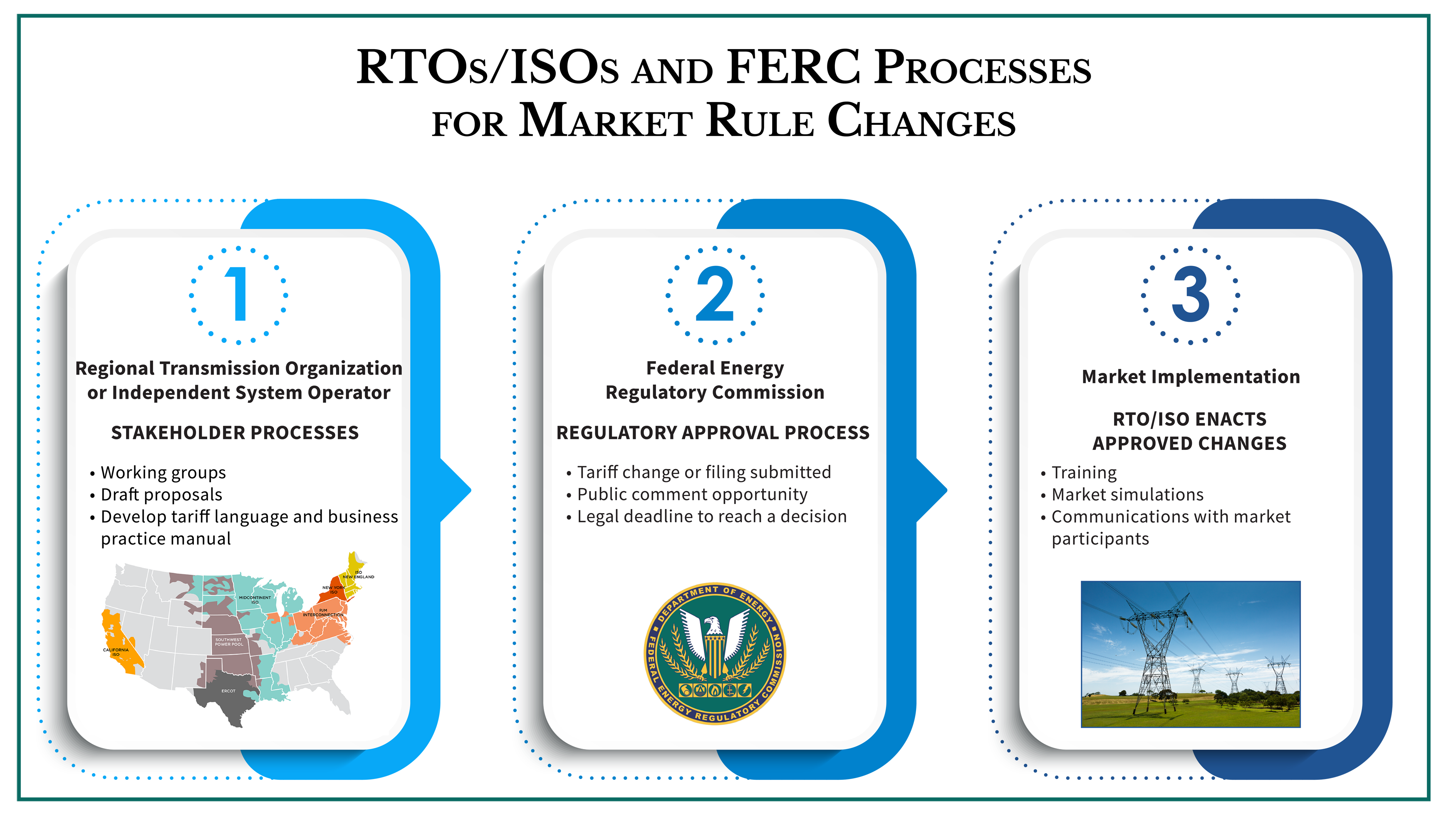What are Wholesale Electricity Markets?
Today, approximately two thirds of the country’s consumers are powered by electricity purchased through wholesale markets. Generators (power plants or other power supply resources) produce electricity and offer it for sale in these markets. Then, suppliers (utilities) purchase the electricity to meet consumer demand.
In the U.S., wholesale electricity markets are managed by nonprofit entities known as regional transmission organizations (RTOs) or independent system operators (ISOs). RTOs and ISOs have a major role in overseeing the flow of electricity within their boundaries. They operate different regional markets across the U.S., managing large-scale transmission networks that move bulk electricity across great distances. These networks are commonly known as the “electric grid” or “power grid.” For this grid, RTOs and ISOs coordinate the flow of electricity across the high-voltage, long-distance powerlines, develop market and reliability rules, and plan for long-term needs of power systems.
FERC reviews RTO and ISO efforts to manage energy markets and ensure reliability and access to the electric grid. Notably, the Electric Reliability Council of Texas (ERCOT) does not fall under FERC’s regulatory jurisdiction.
By contrast, areas without RTOs and ISOs are typically managed by individual utilities. These utilities are often vertically integrated, meaning they handle all the steps involved in providing electricity to customers. This includes the generation, transmission, and distribution of electricity within their service areas. Utilities in these regions are regulated by both federal and state government agencies (commonly referred to as Public Utility Commissions and Public Service Commissions), for various aspects of their activities. Although these regions do not participate in wholesale markets, the federal government oversees aspects of utilities in non-RTO/ISO regions, as it does in areas with RTOs and ISOs. Non-RTO/ISO regions include much of the Southeast, Southwest, and Northwest U.S.
Why Do RTOs/ISOs Matter?
RTOs and ISOs have a significant influence over energy policy in the U.S. RTOs and ISOs’ market rules, operating procedures, and planning processes can impact a variety of policy concerns. For example, RTOs and ISOs oversee how electric transmission lines are built. Those lines may be needed to transport electricity from windy or sunny rural areas to urban areas.
RTOs and ISOs also oversee if and how much energy technologies are compensated for the various services they provide to maintain grid stability. For example, with the rise of intermittent renewable technologies, such as wind, solar, and battery storage, RTOs and ISOs have created new rules to incorporate these technologies into market operations while balancing other concerns, such as reliability.
How Do RTOs and ISOs Work?
In addition to managing grid operations, RTOs and ISOs exist as a kind of middle layer of decision-making between individual utilities and FERC. In this way, RTOs and ISOs host ongoing discussions with utilities and other stakeholders who have an interest in the RTO or ISO’s operations. These discussions focus on the development of new market and operational rules that the RTO or ISO submits to FERC for review. FERC has the final say on changes to RTO and ISO’s protocols and operations.
For more information, see OPP’s explainer An Introductory Guide to Electricity Markets regulated by the Federal Energy Regulatory Commission.
How Can I Get Involved?
RTOs and ISOs are membership organizations, and members of the public can become involved in these “stakeholder processes” as either voting or non-voting members. Stakeholder processes are the primary ways that RTOs and ISOs develop, modify, and propose market rules. Each of the RTO stakeholder processes have unique structures that influence how the RTO operates in the market-rule development process. In the various RTO committees, stakeholders bring forth issues to discuss and, if enough stakeholders support an initiative, they vote to move it forward.
Members of the public may also engage in FERC proceedings when RTOs/ISOs file changes to rules or procedures with FERC. FERC reviews those changes and decides on approval or denial of them. If approved by FERC, final market rules are detailed in tariffs that lay out the current FERC-approved market rules and operations. Tariffs can be thought of as the “rules of the road,” and they set out clear rates and terms of energy service so that markets operate fairly and transparently.
There are also informal pathways for engagement, such as attending public meetings hosted by RTOs, ISOs, or FERC, having direct conversations with RTO leadership or staff, and publicly commenting on relevant issues. Members of the public may choose to engage individually, as a coalition, or in collaboration with others.
Learn More
In 2021, FERC established the Office of Public Participation (OPP) to empower, promote, and support public voices at FERC. If you have any questions about energy markets, please contact OPP via email at [email protected] or by phone at 202-502-6595. OPP has regional staff who monitor energy markets across the U.S. These staff can help connect you to additional resources, relevant proceedings of interest, and public comment and participation opportunities.
Additionally, OPP publishes numerous guidance documents on electric markets, participation, and related topics, as provided on its Markets Resources webpage.
Quick Links
- Petition for Rulemaking by Alliance for Tribal Clean Energy
- Explainer on Siting Interstate Electric Transmission Facilities (FERC Order No. 1977)
- Introduction to Western Markets Expansion
- Pamphlet on Electric Transmission Facilities Permit Process
- WorkshOPP Videos
- OPP Educational Handouts
- Translated Resources


